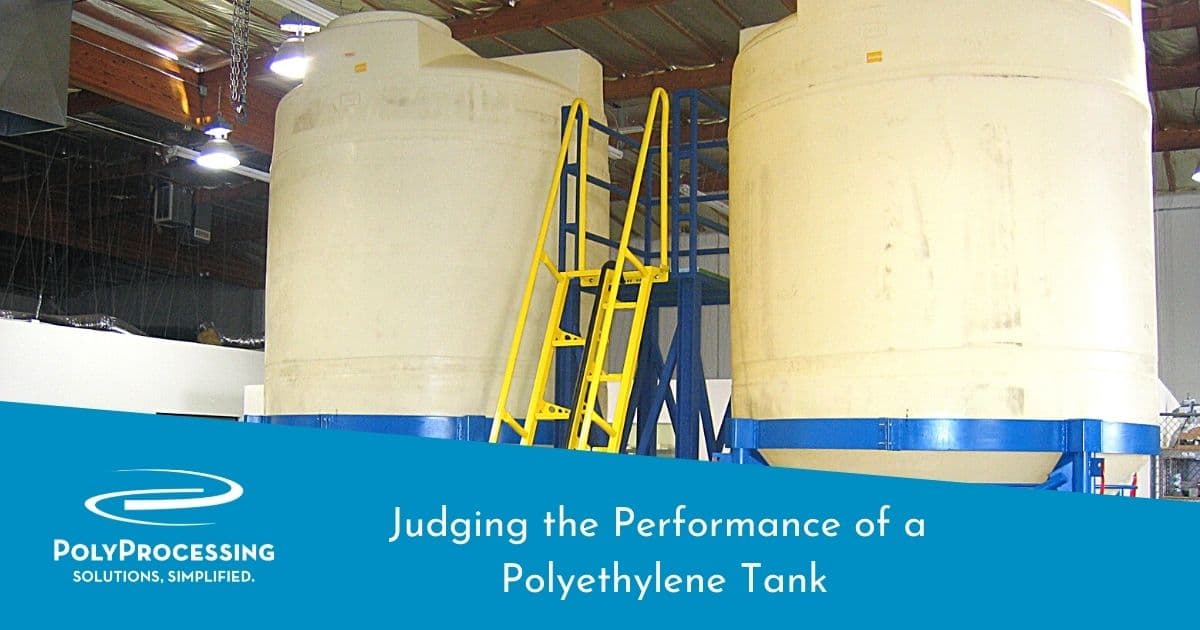Judging the Performance of a Polyethylene Tank
While, at a glance, it’s impossible to gauge the life of your polyethylene chemical storage tank, there are many things to know and consider that will help you extend the life of your tank to its fullest potential. It is important to know that from the production of the tank, through installation, it is expertly manufactured with all of the right gaskets and fittings. After tank installation, it is important to have it inspected regularly to look for problems that could cause tank failure.

Let’s walk through each phase and take a look at what you should consider to appropriately judge the performance of your polyethylene tank.
The Production Stage of Polyethylene
First and foremost, it is critical that you specify the chemical you’ll be storing when you order your tank. The tank is designed and manufactured based on the chemical, so it’s important to know if your chemical tank life can be extended with an antioxidant layer or thicker tank walls based on the specific gravity of the chemical. Additionally, the chemical you are storing will dictate the types of gaskets and fittings used on the tank system.
Thinking ahead in this way makes for a longer useful tank life. It is also important that the material used to manufacture your tank be tested prior to use. Poly Processing performs all ASTM D 1998 testing in-house to ensure your tank is built to last.
The Installation Stage of Polyethylene
Upon installation, it’s very important to have a smooth and clean landing place. One rogue screw or bolt can impact the life of the tank significantly, because it can damage the side wall or floor of the tank.
Fittings and connecting pipes that are installed on the lower third of the sidewall must have flexible connections with correct spring rates for plastic chemical tanks. This mitigates nozzle loading, allows the tank to expand and contract, and protects the tank from pump vibrations.
Having flexible connectors on the lower sidewall is important to the lifespan and performance of your polyethylene tank. If the connectors are not flexible, they cannot move with the tank, creating a hinge point that can cause premature tank failure.
Finally, it is very important to make sure that the tank is vented properly. Whether the tank is mechanically or pneumatically filled, there are venting guidelines that state the minimum venting requirements for different tanks and fill methods. If the tank is under-vented it could lead to mechanical failure from over-pressurization.
It goes without saying that reading the installation guide and appropriate checklists contained within will be well worth the time.
The Inspection Stage of Polyethylene Tanks
Poly Processing recommends inspecting your tank at least once per year. Even relatively new polyethylene tanks should receive routine and careful visual inspections. We offer an inspection checklist that is a good start to inspecting your tank.
These inspection guidelines should be followed at least annually to ensure the safety of personnel and the preservation of the tank and the chemical being stored. The tank should be replaced if it displays stress cracking, crazing, or embrittlement.
Here is a high-level overview of the inspection checklist. Refer to the full document to ensure your inspection is complete.
- Empty the tank. Neutralize any chemical remaining. Thoroughly clean the exterior and interior of the tank. A dirty tank cannot be properly inspected.
- Examine the exterior and the interior of the tank for cracking, crazing and brittle appearance.
- Pay particular attention to areas around fittings and where different portions of the tank converge into one another. In other words, give special attention to “corners” where sidewall and dome meet and where sidewall and bottom meet.
- If a confined space entry is not feasible, use a bright light source to inspect the tank interior from the manway opening. An interior inspection is essential because stress cracks normally show up on the inside of a tank before appearing on the outside.
- Don’t forget to inspect areas of the tank that never actually come in contact with the chemical being stored. With fume-emitting chemicals, oxidation and resulting embrittlement of the dome can occur without any actual contact with the chemical.
- Inspect fittings, flexible connection hoses, and gaskets for leaks and signs of general corrosion or deterioration.
- Inspect vents and fume scrubbers to ensure adequate venting for pressure and vacuum. Ensure the end of the scrubber piping is never submerged in more than 6 inches of liquid.
- Confirm that filling of the tank from tanker trucks is not causing over pressurization and not ending with a line purge that “balloons” the tank.
- Confirm secondary containment is appropriate for chemical being stored, is adequate in size, and is in good repair.
We also have a Field Service Team that can perform tank inspections for you. These skilled experts can even take a sample of your tank back to the facility for an ASTM D 1998 Gel and Impact Test to make sure your cross linked polyethylene tank is still up to the task.
Get in touch with one of our Field Service Technicians today.
- January 3, 2022
- Topics: Value Added
About Poly Processing
Posts By Topic
Tech Talk Podcast Episodes
Subscribe By Email
Recent Posts
- The Best of 2025 - Top 5 Chemical Storage Blogs
- Installation Tips for Chemical Storage Tanks: Site Preparation and Offloading
- Understanding pH and Chemical Concentration When Choosing a Chemical Tank
- Maximizing Fill Efficiency: Selecting the Optimal Fill Line System
- Chemical Storage Tanks: A Quick Guide for End Users
Tank Configurator

Find the recommended tank and system components for your chemical storage challenge.
Configure a Tank Package






